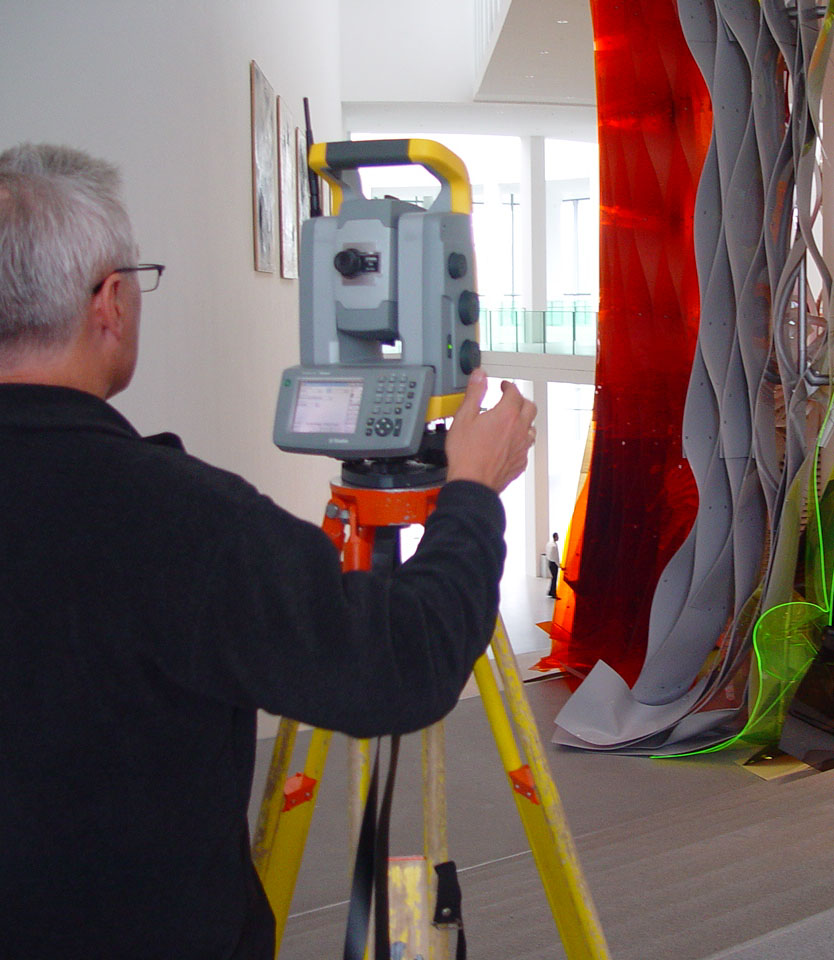 |
|
|
The measurement of installation art (2007)
creator(s) Maike Grün(conservator)
contributors Alexandra Czarnecki (conservation student, Technical University Munich), Christina Spaarschuh (conservator), Peter Weller (surveyor, Weller Vermessung Waltenhofen), Thomas Weber (surveyor, Technical University Munich, Chair of Geodesy, Prof. Th. Wunderlich)

Over the past five years, installation art belonging to the Sammlung Moderne Kunst (Modern Art Collection) at the Pinakothek der Moderne in Munich has been geodetically surveyed. This surveying work has been carried out by applying various methods such as tachymetry, photogrammetry or laser scanning, and has resulted in a number of documents such as floor plans and different views of the particular installation artwork.
The primary objective of these measurements has been to document the artwork. Installations usually consist of several objects whose effect and significance are decisively influenced by their spatial arrangement. A geodectic survey provides highly accurate and fixed coordinates for every object. By contrast, hand drawings based on visual judgement; photographs or video recordings can only define the exact locations of the objects to a limited extent. This leaves room for interpretation.
The installations measured at the Pinakothek der Moderne to date have been installed by the artists themselves or by someone representing them. The recording of these original arrangements has provided vital data relevant to the history of the artwork.
Once the installation artwork has been dismantled and stored away, it automatically loses its spatial context. In the light of this, the survey plans can provide much assistance or even the definitive basis for setting up the artwork again in the event of subsequent reinstallation.
Focus of the special case study
The special case study consists of two investigations into the subject of measuring room installations. The essay by Maike Grün „Measurement of Installation Art. Methods and experience gained at Pinakothek der Moderne“ focuses on the expansive artworks of the artists Joseph Beuys, Pipilotti Rist, Fred Sandback, Mark Manders, Thomas Hirschhorn and Olaf Metzel at the Pinakothek der Moderne. In the same way that these artworks all differ from each other, so, too, do the individual surveying techniques, depending on the particular demands and objectives placed upon them by the installations. Following on from the detailed description of the artwork, objectives, procedures and survey plans is an evaluation of the methods from the conservation point of view. Wherever possible, the artists were asked for their personal opinions on the measuring and use of the surveying plans for reinstallation. Each case study is illustrated with images of the artwork, the measuring process and the recorded plans.
Click download to access Measurement_at_Pinakothek_der_Moderne.pdf In her essay „ Verfahren und Instrumente zur Vermessung von Rauminstallationen – ein Überblick” („Overview of possible techniques and instruments for measuring installation artworks“, which is available only in German)
Alexandra Czarnecki investigates the basis for measuring techniques. She illustrates how the different measuring instruments work – for instance, the tachymeter or laser scanner – and provides the reader with insights into the processes of selected methods of measurement.
Click download to access ‘Verfahren undInstrumente Vermessung’
Results of the special case study The special case study presents for the first time an overview of standard professional methods of measurement and their application to installation art. Museum professionals now have for the first time a structured overview of the different kinds of measuring techniques that provide a basis for preserving spatially complex artworks.
 Copyright Protected Copyright Protected
|
|
|